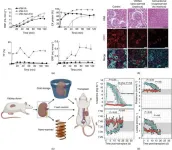(Press-News.org) Those with access to firearms rarely use their weapon to defend themselves, and instead are far more likely to be exposed to gun violence in other ways, according to a Rutgers Health study.
An overwhelming majority of firearm users, or about 92%, indicated they never have used their weapons to defend themselves, with less than 1% say they did in the previous year, a new study by the New Jersey Gun Violence Research Center found.
“Adults with firearm access are far more likely to be exposed to gun violence than they are to defend themselves with their firearms,” said Michael Anestis, executive director of the New Jersey Gun Violence Research Center at Rutgers and lead author of the study. “It’s not that defensive gun use never happens, but the notion that firearm owners are routinely saving their own lives or those of their loved ones by using a firearm in self-defense simply is not backed up by the data. When we consider policies, we need to more heavily weigh the harms that frequently occur, not the instances of defense that rarely happen.”
The study, which appears in JAMA Network Open, collected data from a nationally representative sample of 8,009 adults in May 2024 and examined how frequently the 3,000 with firearm access had engaged in defensive gun use and been exposed to gun violence, both across their entire lives and within the past year.
More than one-third (34.4%) said they had known someone who had died by firearm suicide. In the past year, 32.7% said they had heard gunshots in their neighborhood. Although only 2.1% of the sample indicated they had been shot, 59.5% of all instances of defensive gun use during which an individual shot at a perceived threat occurred among those who had previously been shot themselves.
The researchers also examined which individuals were most likely to have engaged in defensive gun use in their lifetimes. Those with previous exposure to gun violence, who carry firearms more frequently and who tend to store firearms loaded and unlocked were more likely to indicate they had engaged in at least one form of defensive gun use.
“If individuals themselves have experienced gun violence or they more frequently have quick and ready access to their firearms, they may be more prone to perceiving threats and responding through the use of their firearm,” Anestis said. “It is important to note that, just because someone perceives someone else as a threat does not mean they were one and, if someone truly is a threat, that does not always mean a firearm is necessary for defense. When defensive gun use occurs, we should not necessarily conclude that the result was a life saved that otherwise would have been lost.”
END
Defensive firearm use is far less common than exposure to gun violence
A Rutgers Health study highlights that less than 1% of people with firearm access engage in defensive use in any given year
2025-03-14
ELSE PRESS RELEASES FROM THIS DATE:
Lifetime and past-year defensive gun use
2025-03-14
About The Study: In this survey of adults with firearm access, defensive gun use (DGU) was rare relative to gun violence exposure. Perceived threats may not necessitate DGU, and given the association between DGU and gun violence exposure, the consequences of DGU may be substantial. Narratives centering DGU as a consideration in firearm policies may misstate the risk profile of firearm access.
Corresponding Author: To contact the corresponding author, Michael D. Anestis, PhD, email mda141@sph.rutgers.edu.
To access the ...
Lifetime health effects and cost-effectiveness of tirzepatide and semaglutide in US adults
2025-03-14
About The Study: This economic evaluation found that although tirzepatide and semaglutide offered substantial long-term health benefits, they were not cost-effective at current net prices. Efforts to reduce the net prices of new anti-obesity medications are essential to ensure equitable access to highly effective anti-obesity medications.
Corresponding Author: To contact the corresponding author, Jennifer H. Hwang, DO, email jennifer.hwang2@bsd.uchicago.edu.
To access the embargoed study: Visit our For The Media website at this link https://media.jamanetwork.com/
(doi:10.1001/jamahealthforum.2024.5586)
Editor’s ...
New members of the CDKL family of genes linked to neurodevelopmental disorders
2025-03-14
CDKL5, one of the five members of the CDKL family of genes, is important for proper neurodevelopment and associated with seizures. However, the role the other four members of this family play in health and disease is unknown.
A team led by researchers at Baylor College of Medicine and the Jan and Dan Duncan Neurological Research Institute (Duncan NRI) at Texas Children’s Hospital has deepened our understanding of two other members of the CDKL family, CDKL2 and CDKL1. The labs of Drs. Oguz Kanca and Hugo Bellen show that ...
Advancements in organ preservation: paving the way for better transplantation outcomes
2025-03-14
A review article published in Engineering delves into the crucial field of organ preservation, exploring its history, current techniques, and future prospects. The shortage of donor organs remains a significant global challenge, with only about 10% of the global demand for organ transplantation being met, as stated by the World Health Organization. This shortage is further exacerbated by the limitations of current organ preservation methods.
Currently, the main clinical methods for organ preservation are static cold storage (SCS) and machine perfusion (MP). SCS, which involves storing organs in a preservation solution at low temperatures (usually 4 °C), is simple and ...
Pitt study makes new insights into the origins of ovarian cancer
2025-03-14
Researchers at the University of Pittsburgh have identified a novel trigger of a deadly form of ovarian cancer: a subset of progenitor cells that reside in fallopian tube supportive tissue, or stroma.
The discovery of these high-risk cells, described in a new study published today in Cancer Discovery, a journal of the American Association for Cancer Research, could pave the way for better approaches to prevent and detect high-grade serous ovarian cancer (HGSOC), the most common form of ovarian cancer, which kills more than 12,000 women in the U.S. each year.
“Ovarian cancer is the leading cause of death from gynecologic cancer in the Western world, but we currently ...
Topical steroid withdrawal diagnostic criteria defined by NIH researchers
2025-03-14
WHAT:
Researchers at the National Institutes of Health (NIH) have determined that dermatitis resulting from topical steroid withdrawal (TSW) is distinct from eczema and is caused by an excess of an essential chemical compound in the body. Scientists from NIH’s National Institute of Allergy and Infectious Diseases (NIAID) identified treatments that could be studied in clinical trials for the condition based on their potential to lower levels of the chemical compound—called nicotinamide adenine dinucleotide (NAD+), a form of ...
CeSPIACE: A broad-spectrum peptide inhibitor against variable SARS-CoV-2 spikes
2025-03-14
SARS-CoV-2, the virus responsible for COVID-19, infects cells by binding its spike protein to angiotensin-converting enzyme 2 (ACE2) receptors. Blocking this interaction with inhibitors could prevent infection. Since these inhibitors act directly on the virus without affecting human cells, they may be safer than some existing treatments. However, mutations in the spike protein can alter its structure, reducing the effectiveness of these inhibitors.
In a significant breakthrough, a research team led by Professor Yoshinori Fujiyoshi ...
Understanding the origin of magnetic moment enhancement in novel alloys
2025-03-14
Magnetic materials have become indispensable to various technologies that support our modern society, such as data storage devices, electric motors, and magnetic sensors. High-magnetization ferromagnets are especially important for the development of next-generation spintronics, sensors, and high-density data storage technologies. Among these materials, the iron-cobalt (Fe-Co) alloy is widely used due to its strong magnetic properties. However, there is a limit to how much their performance can be improved, necessitating a new approach.
Some of the earlier studies have shown that epitaxially grown films made up of Fe-Co alloys doped with heavier elements exhibit remarkably high ...
BU researchers develop computational tools to safeguard privacy without degrading voice-based cognitive markers
2025-03-14
(Boston)—Digital voice recordings contain valuable information that can indicate an individual’s cognitive health, offering a non-invasive and efficient method for assessment. Research has demonstrated that digital voice measures can detect early signs of cognitive decline by analyzing features such as speech rate, articulation, pitch variation and pauses, which may signal cognitive impairment when deviating from normative patterns.
However, voice data introduces privacy challenges due to the personally identifiable information embedded in recordings, ...
Breakthrough in rapid polymer nanostructure production
2025-03-14
Researchers at the University of Birmingham have developed a new method for the rapid scalable preparation of uniform nanostructures directly from block polymers.
This novel approach, led by the Dove and O'Reilly groups, significantly reduces processing time from a week to just minutes, enabling high-throughput production of precision polymer nanomaterials.
Publishing their findings today (14 Mar) in Nature Chemistry, the teams outline a rapid seed preparation technique that supersaturates polymer solutions in a flow system.
The process facilitates uniform seed micelle formation and allows ...
LAST 30 PRESS RELEASES:
Tracing the quick synthesis of an industrially important catalyst
New software sheds light on cancer’s hidden genetic networks
UT Health San Antonio awarded $3 million in CPRIT grants to bolster cancer research and prevention efforts in South Texas
Third symposium spotlights global challenge of new contaminants in China’s fight against pollution
From straw to soil harmony: International team reveals how biochar supercharges carbon-smart farming
Myeloma: How AI is redrawing the map of cancer care
Manhattan E. Charurat, Ph.D., MHS invested as the Homer and Martha Gudelsky Distinguished Professor in Medicine at the University of Maryland School of Medicine
Insilico Medicine’s Pharma.AI Q4 Winter Launch Recap: Revolutionizing drug discovery with cutting-edge AI innovations, accelerating the path to pharmaceutical superintelligence
Nanoplastics have diet-dependent impacts on digestive system health
Brain neuron death occurs throughout life and increases with age, a natural human protein drug may halt neuron death in Alzheimer’s disease
SPIE and CLP announce the recipients of the 2025 Advanced Photonics Young Innovator Award
Lessons from the Caldor Fire’s Christmas Valley ‘Miracle’
Ant societies rose by trading individual protection for collective power
Research reveals how ancient viral DNA shapes early embryonic development
A molecular gatekeeper that controls protein synthesis
New ‘cloaking device’ concept to shield sensitive tech from magnetic fields
Researchers show impact of mountain building and climate change on alpine biodiversity
Study models the transition from Neanderthals to modern humans in Europe
University of Phoenix College of Doctoral Studies releases white paper on AI-driven skilling to reduce burnout and restore worker autonomy
AIs fail at the game of visual “telephone”
The levers for a sustainable food system
Potential changes in US homelessness by ending federal support for housing first programs
Vulnerability of large language models to prompt injection when providing medical advice
Researchers develop new system for high-energy-density, long-life, multi-electron transfer bromine-based flow batteries
Ending federal support for housing first programs could increase U.S. homelessness by 5% in one year, new JAMA study finds
New research uncovers molecular ‘safety switch’ shielding cancers from immune attack
Bacteria resisting viral infection can still sink carbon to ocean floor
Younger biological age may increase depression risk in older women during COVID-19
Bharat Innovates 2026 National Basecamp Showcases India’s Most Promising Deep-Tech Ventures
Here’s what determines whether your income level rises or falls
[Press-News.org] Defensive firearm use is far less common than exposure to gun violenceA Rutgers Health study highlights that less than 1% of people with firearm access engage in defensive use in any given year




